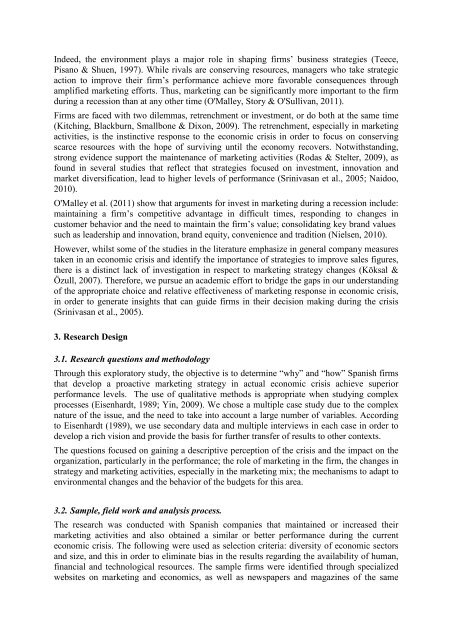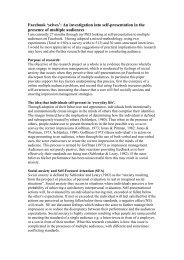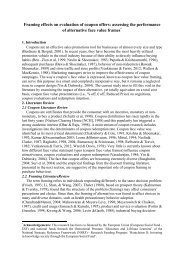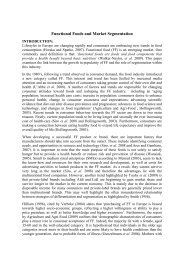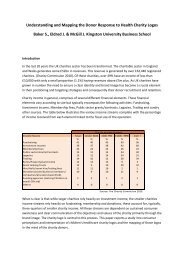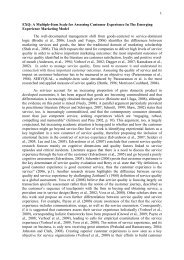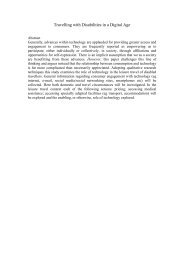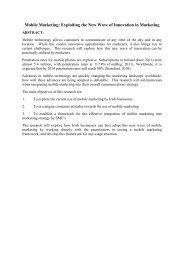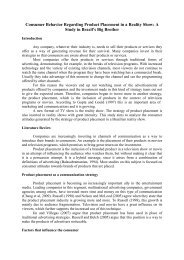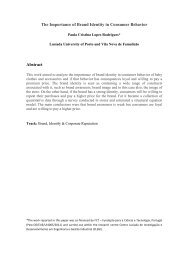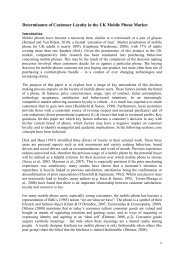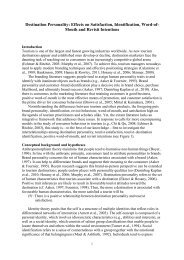from crisis to opportunity - Academy of Marketing
from crisis to opportunity - Academy of Marketing
from crisis to opportunity - Academy of Marketing
You also want an ePaper? Increase the reach of your titles
YUMPU automatically turns print PDFs into web optimized ePapers that Google loves.
Indeed, the environment plays a major role in shaping firms’ business strategies (Teece,<br />
Pisano & Shuen, 1997). While rivals are conserving resources, managers who take strategic<br />
action <strong>to</strong> improve their firm’s performance achieve more favorable consequences through<br />
amplified marketing efforts. Thus, marketing can be significantly more important <strong>to</strong> the firm<br />
during a recession than at any other time (O'Malley, S<strong>to</strong>ry & O'Sullivan, 2011).<br />
Firms are faced with two dilemmas, retrenchment or investment, or do both at the same time<br />
(Kitching, Blackburn, Smallbone & Dixon, 2009). The retrenchment, especially in marketing<br />
activities, is the instinctive response <strong>to</strong> the economic <strong>crisis</strong> in order <strong>to</strong> focus on conserving<br />
scarce resources with the hope <strong>of</strong> surviving until the economy recovers. Notwithstanding,<br />
strong evidence support the maintenance <strong>of</strong> marketing activities (Rodas & Stelter, 2009), as<br />
found in several studies that reflect that strategies focused on investment, innovation and<br />
market diversification, lead <strong>to</strong> higher levels <strong>of</strong> performance (Srinivasan et al., 2005; Naidoo,<br />
2010).<br />
O'Malley et al. (2011) show that arguments for invest in marketing during a recession include:<br />
maintaining a firm’s competitive advantage in difficult times, responding <strong>to</strong> changes in<br />
cus<strong>to</strong>mer behavior and the need <strong>to</strong> maintain the firm’s value; consolidating key brand values<br />
such as leadership and innovation, brand equity, convenience and tradition (Nielsen, 2010).<br />
However, whilst some <strong>of</strong> the studies in the literature emphasize in general company measures<br />
taken in an economic <strong>crisis</strong> and identify the importance <strong>of</strong> strategies <strong>to</strong> improve sales figures,<br />
there is a distinct lack <strong>of</strong> investigation in respect <strong>to</strong> marketing strategy changes (Köksal &<br />
Özull, 2007). Therefore, we pursue an academic effort <strong>to</strong> bridge the gaps in our understanding<br />
<strong>of</strong> the appropriate choice and relative effectiveness <strong>of</strong> marketing response in economic <strong>crisis</strong>,<br />
in order <strong>to</strong> generate insights that can guide firms in their decision making during the <strong>crisis</strong><br />
(Srinivasan et al., 2005).<br />
3. Research Design<br />
3.1. Research questions and methodology<br />
Through this explora<strong>to</strong>ry study, the objective is <strong>to</strong> determine “why” and “how” Spanish firms<br />
that develop a proactive marketing strategy in actual economic <strong>crisis</strong> achieve superior<br />
performance levels. The use <strong>of</strong> qualitative methods is appropriate when studying complex<br />
processes (Eisenhardt, 1989; Yin, 2009). We chose a multiple case study due <strong>to</strong> the complex<br />
nature <strong>of</strong> the issue, and the need <strong>to</strong> take in<strong>to</strong> account a large number <strong>of</strong> variables. According<br />
<strong>to</strong> Eisenhardt (1989), we use secondary data and multiple interviews in each case in order <strong>to</strong><br />
develop a rich vision and provide the basis for further transfer <strong>of</strong> results <strong>to</strong> other contexts.<br />
The questions focused on gaining a descriptive perception <strong>of</strong> the <strong>crisis</strong> and the impact on the<br />
organization, particularly in the performance; the role <strong>of</strong> marketing in the firm, the changes in<br />
strategy and marketing activities, especially in the marketing mix; the mechanisms <strong>to</strong> adapt <strong>to</strong><br />
environmental changes and the behavior <strong>of</strong> the budgets for this area.<br />
3.2. Sample, field work and analysis process.<br />
The research was conducted with Spanish companies that maintained or increased their<br />
marketing activities and also obtained a similar or better performance during the current<br />
economic <strong>crisis</strong>. The following were used as selection criteria: diversity <strong>of</strong> economic sec<strong>to</strong>rs<br />
and size, and this in order <strong>to</strong> eliminate bias in the results regarding the availability <strong>of</strong> human,<br />
financial and technological resources. The sample firms were identified through specialized<br />
websites on marketing and economics, as well as newspapers and magazines <strong>of</strong> the same


